|

This lithographic print by Charles Magnus, which
is part of the University Archives collection,
depicts Columbian College and Carver Barracks
on College Hill in Washington, 1864.
By G. David Anderson
The American Civil War split Columbian
College as it did the nation. South of the Mason
Dixon Line, Washington was considered a Southern
city. When the conflict began, most students
left their classrooms to join the Southern forces,
while the faculty was split by opposing loyalties.
Because of its status as the nation’s capital
and its geographic location, the district soon
became the staging area for the Union. By order
of newly elected President Lincoln, the district
and the campus of Columbian College (original
name of The George Washington University) was
converted to barracks, accommodations for the
sick, troop quarters, and hospitals.

|
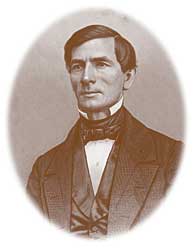
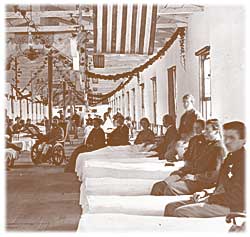 (above) George W. Samson was president of
Columbian College from 1859 to 1871. (below)
This photo, from the Matthew Brady collection
at the National Archives, shows the interior
of Carver Hospital.
(above) George W. Samson was president of
Columbian College from 1859 to 1871. (below)
This photo, from the Matthew Brady collection
at the National Archives, shows the interior
of Carver Hospital.
|
Chartered in 1821, Columbian College’s
first location was known as “College Hill.” This
46.5-acre tract of land extended north of Boundary
Street (now Florida Avenue) between 14th and
15th Streets. Purchased for $7,000, the land
was owned by John Holmead, who resided at Meridian
Hill. The campus was within walking distance
of the Capitol. The College’s central building
was a large structure for classes and boarding
that accommodated 100 students. Three smaller
buildings housed professors, the College president,
and the College steward. Classes began in January
1822 with 30 students registered for the first
term. In the years preceding the Civil War, approximately
300 students received their degrees from the
College.
In the mid-1800s, the city was growing and changing.
By 1853 Washington had installed gas lamps along
major streets. Washington’s first water
system was completed by 1859. By 1860 the population
had grown to 75,080.
The fifth president of Columbian College, George
Whitefield Samson, was elected in 1859. Samson
was pastor of the E Street Baptist Church in
Washington. He ended his tenure in 1871 as professor
of moral and intellectual philosophy. He had
the difficult duties of directing the College
during the years leading to, during, and after
the Civil War. With the aid of his colleagues
he kept the College open and worked to reestablish
the Law Department.
After the election of Abraham Lincoln, a known
anti-slavery proponent, the South seceded. In
January 1861 the South Carolina legislature called
a state convention and voted to leave the Union.
Virginia would secede in April of the same year
and by July the First Battle of Bull Run would
be fought just outside Washington. Samson reported
to the Board of Trustees on April 24, 1861, that
20 students out of 155 had left the College “owning
to the disturbed condition of the country.”
Curriculum at the College on the eve of the Civil
War was composed of a classical course for the
degree of Bachelor of Arts, a philosophical course
for a Bachelor of Philosophy, a select course
for master’s level study, a Medical Department
and hospital, and a successful Preparatory School.
The Preparatory School played a major role in
the life of the College, as it was a popular
place for students to prepare for admission to
Columbian or other colleges.
Courses at the College included Greek, Latin,
mathematics, modern languages, rhetoric, chemistry,
physics, botany, logic, intellectual philosophy,
astronomy, anatomy and physiology, ethical history,
political philosophy, and English literature.
Rhetorical exercises included compositions twice
and declamations once a month. There were two
literary societies. Both the Enosinian and the
Philophrenian Societies were formed by students.
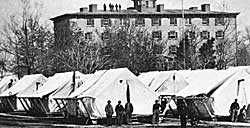
Columbian College General Hospital,
with the main building of Columbian College
in the background and Union troops encamped
in the foreground. The original photo is
part of the Ordway Collection at the Library
of Congress.
|

|
Fees for students were $10 for admission, $55
for tuition, $20 for room rent with servant’s
attendance (slaves were not permitted), $15
for fuel, $10 for use of furniture (if provided
by the college); and $10 for washing at 50
cents per dozen. Of interest was the acceptance
by the College, as the war began, of Virginia
money for some payments.
The Preparatory Department had a principal and
five assistant teachers. The Preparatory Department
occupied a building on the College premises.
The students were under the supervision of the
faculty and subject to all regulations of the
College in regard to discipline. In the 1860-61
academic year there were 69 students.
In 1860 Columbian College students helped in
the construction of a gymnasium on College Hill.
By 1860 one fraternity, the Washington Rho chapter
of Sigma Alpha Epsilon, was active at Columbian
College. SAE was founded in 1856 at the University
of Alabama in Tuscaloosa by Noble Leslie DeVotie.
His younger brother, Jewett DeVotie, organized
the 10th chapter of SAE at Columbian College.
Most “brothers” of SAE fought for
the South. Only at Columbian College and Kentucky
did SAE members fight for the Union. Washington
Rho at Columbian College was the only chapter
to survive the Civil War. Other chapters were
re-established with the end of the war.
With the secession and the start of war the city
was becoming an armed camp. One of the few public
improvements was the installation of the equestrian
statue of George Washington at Washington Circle
(1860) in the area that would be the future home
of The George Washington University.
The citizens of the district were split in their
loyalty to North and South. The city, for the
most part, was undefended and was certainly not
prepared to house all the troops to come or respond
to the multiple wounded. Because of its location,
the district became the principle receiving point
for wounded and sick and the gateway to invasion
in the South.

|
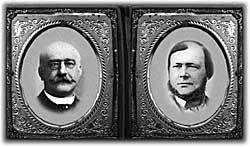
(left) Columbian College professor
Albert Freeman Africanus King was
one of several physicians who tended
to President Lincoln immediately
after he was shot. (right) Robert
King Stone was Lincoln’s
personal physician.
|
The Union forces commandeered all churches, public
buildings, large private homes, and academic
institutions. In addition to barracks, and governmental
and military operations, the district essentially
became one large hospital.
The Army commandeered
the College Hill campus and the hospital downtown.
Despite reduced enrollment, professors continued
to hold classes, often in their homes. From 1861
to 1865 the College had 194 registered students.
The Preparatory School had 357 students. The
medical graduates served
during the war—46 for the Union, 24 for
the South. Many faculty members also served,
including Dr. John G. F. Holston, professor of
surgery, and Dr. Joseph H. Warren, professor
of anatomy.
The Army moved onto the campus, often occupying
areas without permission. The fence surrounding
the campus was partially destroyed by solders
of the Third Maine Regiment of Volunteers. The
Army reimbursed the College for the damages.
The government also agreed to rent the campus
for $350 per month. This fee was later reduced
to $250. In addition, by October 1862 the steward’s
house was rented and 16 acres of the campus were
occupied for barracks. The College’s association
with the army was not a pleasant one. The College
water pump was used by 3,000 men and damage to
College facilities mounted as the war continued.
Within the campus the Columbian College and Carver
general hospitals were established. Carver had
1,300 beds and Columbian College 844. During
the war these hospitals were visited by President
Lincoln. Walt Whitman also devoted time to the
patients at Carver Hospital.
The Washington Infirmary at Judiciary Square
was a teaching hospital, home to the Medical
Department since the 1840s, and a meeting place
for the Medical Society of the District of Columbia.
The infirmary enjoyed several prosperous years,
but with the beginning of the American Civil
War, the school entered a difficult era. The
infirmary was the only available hospital in
the district. In April 1861 it was requisitioned
for military use.
As the city was mostly undefended, the Sixth
Massachusetts Regiment was ordered to move to
Washington. While marching through Baltimore,
the unit was attacked by hostile mobs of Southern
loyalists. Many of the wounded were moved to
the Washington Infirmary. After the First Battle
at Bull Run the number of wounded increased.
The Southern threat to the city was very real.
Enemy gun sites could be seen across the Potomac.
It was essential that Washington be protected.
As a result Arlington, Alexandria, and surrounding
areas in Virginia were captured and occupied
by Union forces. Afterwards a series of forts
were established, surrounding the city.
The Washington Infirmary would survive the war
for only six months. On Nov. 4, 1861, a fire
completely destroyed the hospital and the offices
of the medical school. The
Washington Star reported
in 1861 that more than 100 patients were removed
from the building (one patient died). By the
time the fire engines arrived the facility was
destroyed. So ended GW’s first established
teaching hospital.
Despite the chaos of the war, the medical college
regrouped and in 1863 reopened in the Constitution
Office on E Street between 12th and 13th Streets,
N.W. Because of the depletion of students and
faculty members, lectures at the medical school
were suspended between 1863 and 1865.
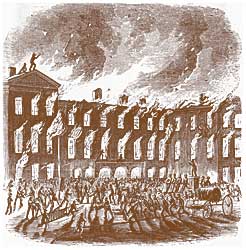
This illustration from the Nov. 23,
1861, Harper’s Weekly shows the burning
of the Washington Infirmary on Nov. 4,
1861. The infirmary was home of Columbian
College’s clinical hospital and medical
school. The fire completely destroyed the
hospital and the medical school offices.
Only one of 100 patients is reported to
have died in the fire. The rest escaped
or were rescued.
In the 1840s, the Department of Medicine
had moved into the infirmary, which was
formerly the old jail at Judiciary Square.
It was then that it became known as the
Washington Infirmary and the National Medical
College, one of the nation’s first
teaching hospitals.
|

|
Beginning a long tradition of GW service to
presidents, medical faculty member Dr. A.Y.P.
Garnett left Washington to become Jefferson Davis’ personal
physician, while faculty member Dr. Robert
King Stone remained to serve Abraham Lincoln.
Garnett knew many Washington officials. In order
to go to Virginia, Garnett had to ask permission
and obtain a passport from the Secretary of War
to travel to the South. He later became physician
to the Lee family and Jefferson Davis. In charge
of Richmond Hospitals, Garnett returned to
his practice in Washington at the end of the
war.
At approximately 10:15 p.m. on April 14, 1865,
Lincoln was shot in the back of the head by John
Wilkes Booth. After being taken from Ford’s
Theater, Lincoln was attended by several physicians.
Among them were Columbian College professors
Dr. John F. May and Dr. A.F.A. King
At Lincoln’s bedside surgeons Joseph K.
Barnes and Robert King Stone found the wound
to be mortal.
At the end of the Civil War the army and other
government authorities made slight repairs to
the main College building, the Steward’s
house, and the engine room, which heated both
buildings. They declined to repair the boiler
and fixtures or repair the pipes damaged by overuse
and improper drainage. In 1868 President Samson
requested the Board of Trustees allocate $2,500
for repairs to the Steward’s house, occupied
by the principal of the Preparatory School, and
the library, which was relocated to the upper
room of the building formerly occupied by the
Preparatory Department.
In 1865 the Law School was re-established.
From 1865 to 1867 the medical school shared
space in the Columbian College Law Building
on 5th Street between D and E Streets, N.W.
The Law building also served as a church
on Sundays.
The hospital and medical school moved to 1335
H Street in 1868. The new building, which previously
housed the Army Medical Museum’s specimens,
was donated by W.W. Corcoran, philanthropist
and president of the Board of Trustees from 1869
to 1888. Medical school and law school lectures
were held in the late afternoon or evening to
accommodate federal workers.
By 1870 Washington’s population reached
109,000. Washington was a growing community.
By 1871 the president’s annual report listed
a total of 376 students. After the war and in
spite of the conflict that split the College
and the nation, the College was recording an “unusually
large number of applications, particularly from
the Southern States.” Even with the neglected
condition of its campus, Columbian College resumed
its role as a key institution of higher learning
in the District of Columbia.
G. David Anderson is the University Archivist
and Historian. Information for the article came
from a variety of sources, among them the books,
records, and visual materials found in the University
Archives. Additional sources include: the books
and writings of Elmer Louis Kayser, the University’s
first official historian; Capital Medicine:
A Tradition of Excellence by Nancy B. Paull; City
of Magnificent Intentions by Keith Melder;
and Washington At Home, edited by Kathryn
Schneider Smith. Also, information was pulled
from the Ford’s Theater National Information Site.
|